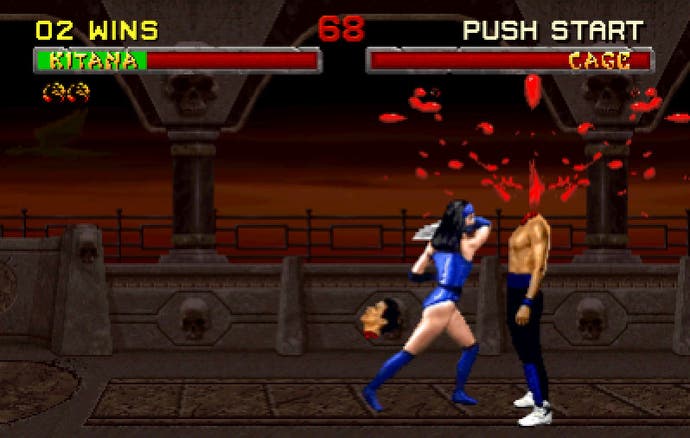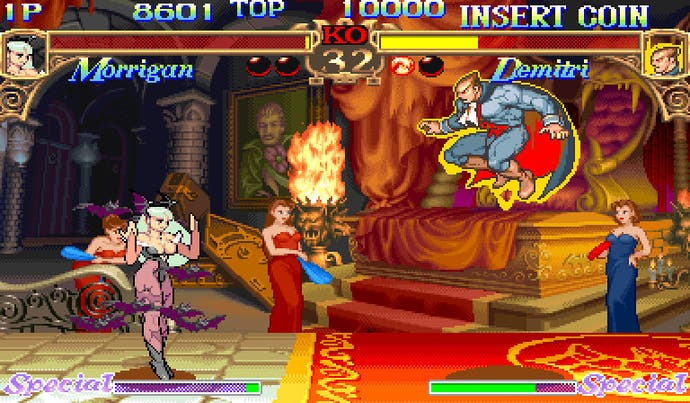Beginner's Guide: Fighting Games
The ultimate combo ice breaker.
The fighting genre's next major milestone was just around the corner. Sega's Virtua Fighter (1993) was the first of a new breed of fighting games that featured characters constructed from polygon and in addition to the aesthetical shift, Virtua Fighter laid the foundation for 3D fighting mechanics.
Hot on the heels of Virtua Fighter was Tekken (1994), the inaugural title of the best selling fighting game series to date. It was at the crest of a wave of other prominent 3D fighting games - including Dead or Alive (1996), Bloody Roar (1997) and Soulcalibur (1998) - as well as two of the greatest 2D fighting games ever made in both Street Fighter III: 3rd Strike (1999) and Garou: Mark of the Wolves (1999). Their respective Parrying and Just Defend systems proved that a strong defence was just as important as a steady offence.
It would also be disingenuous not to mention Power Stone (1999), Capcom's 3D arena fighter, and Super Smash Bros. (1999), as both these games steered the genre into fresh new territory. "I was amazed by the consistent control style for all characters in Super Smash Bros", enthuses Yoshinori Ono, Producer of Street Fighter IV, "The development team put effort into lowering the entry barrier. They also incorporated the stage structure into the gameplay, adding flexibility. I hope, one day, we will do our interpretation of this type of game."
The post millennium period then saw a cool-down period where the popularity of fighting games began to decline in the West. Fighting games continued to be released, but a lull had been reached - though thankfully, the second (and ongoing) golden age of fighting games was only a few years down the road.
Reading List - Current Contenders
Super Street Fighter IV: Arcade Edition (360, PS3, PC)
Street Fighter IV took the original World Warriors sprites and re-sculpted them into 3D with a flexible combat system that layered the accessibility of Ultra combos with the hidden depth of the Focus system.
Tekken 6 (360, PS3)
While Street Fighter was missing in action for nearly a decade, the Tekken series maintained a strong position in arcades and on consoles. Its latest instalment also introduced a "Rage" system that lets players do more damage with their last slither of health.

BlazBlue: Continuum Shift (360, PS3)
While most other studios were jumping on the 2.5D bandwagon - with fighting games that used 3D polygons and 2D mechanics - Arc System Works crafted a sprite-based fighter with boundless beauty.
Marvel vs. Capcom 3: Fate of Two Worlds (360, PS3)
Crafting a sequel for the highly revered Marvel vs. Capcom 2 was never going to be easy, but Capcom pulled out all the stops with a chaotic fusion of diverse characters and combo flexibility.
Mortal Kombat (360, PS3)
After years of flirting with 3D fighting systems, and failing to deliver anything particularly special, NetherRealm Studios exhumed the remains of the original MK trilogy and fashioned them into a capable 2D fighting game with character and depth.
Reading List - Classic Collection
SoulCalibur (XBLA)
Although Soul Edge introduced players to the Katana skills of Mitsurugi, it was the release of Soulcalibur on the Dreamcast that cemented the series as a heavy hitter - partly thanks to its evasive Eight-Way Run system.
Street Fighter Anniversary Collection (Xbox)
Anniversary Collection is worth its weight in gold as it contains Street Fighter III: 3rd Strike, Street Fighter II: The Animated Movie and Hyper Street Fighter II - the latter being an amalgamation of Street Fighter II and its four main revisions.
Garou: Mark of the Wolves (XBLA)
With a back-catalogue of fighting games to rival even Capcom, picking a single SNK game is always a painstaking task, but amongst the regal tournaments and samurai conflicts, there's Garou: Mark of the Wolves - the final instalment in the Fatal Fury series and SNK's counter dunk to 3rd Strike.
State of play
Following the console release of Street Fighter IV and BlazBlue: Calamity Trigger in 2009, fighting games have seen a resurgence in Western popularity. The quality of titles has also increased, but when you look at games like The King of Fighters XII and Mortal Kombat, the level of progression is gradual rather than dramatic.

"It's difficult, certainly", Arc System Works' Daisuke Ishiwatari muses. "When you look at Smash Bros and PowerStone, these games add additional players and power-ups to try and broaden the experience, but in doing so, they move away from a classic 'fighting game'. With games like Guilty Gear and Street Fighter, the template is very simple - two human opponents - one wins, one loses. It's a scenario that's older than videogames. How we continue to explore that dynamic is down to the creator's imagination."
But while we wait for a game to come along that drop kicks the rule book out the window, and astounds us with an entirely new way of beating the virtual crap out of each other (and no, The Fight: Lights Out doesn't count), fighting games are also making important steps in other areas. This includes the online functionality provided by Xbox Live and PlayStation Network.
"With internet connectivity expanding and connection speeds getting faster and more reliable, the competitive desire that drove fighting games in the past has returned," Garcia described. "As a player, you have more access to competition, which drives you to improve. Players can easily find tips, footage and other information online about improving their own fighting game skills. This leads to more people playing at a higher level."
